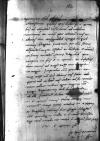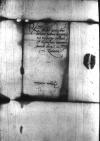List #5629
Jan CHOJEŃSKI do Ioannes DANTISCUSCracow (Kraków), 1537-10-23
| odebrano [1537]-10-30 Rękopiśmienne podstawy źródłowe:
Pomocnicze podstawy źródłowe:
| ||||||
Tekst + aparat krytyczny + komentarzZwykły tekstTekst + komentarzTekst + aparat krytyczny
Reverendissimo in Christo Patri, domino, domino
Reverendissime in Christo Pater, domine mi a[mice et] frater carissime.
Quibus opus habuit Paternitas Vestra Reverendissima litteris ad obtinendam translationem ad
Negotia Prutenica per omnia ferme absolventur iuxta cf.
Cupio bene valere Vestram Dominationem Reverendissimam. Cuius fraterno amori me commendo.
Vestrae Dominationis Reverendissimae frater
Postscript:
Dominus

